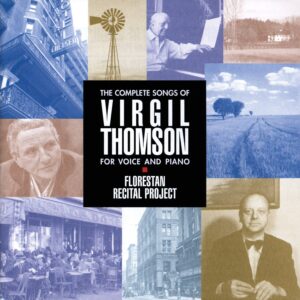Virgil Thomson wrote songs all his long life. He had a formidable reputation as a setter of words, whose sense of prosody allowed no unintelligible phrases, no falsely accented syllables, no vowels obscured. Musically speaking, Thomson spent his career going back and forth between stylistic options. Here’s Thomson’s “Cubist Satie” style, referring to simple phrases displaced or cadences deliberately resolved on the wrong beats, as heard in “Le Berceau De Gertrude Stein Ou Le Mystère De La Rue De Fleurus” and the cycle La Belle En Dormant. Thomson’s setting of Gertrude Stein’s “Susie Asado” exemplifies his terse, linear, sparse, and somewhat discontinuous style. He could do petulant dissonance as well as Copland or Antheil in their early periods (“The Tiger”), but even Thomson’s seemingly benign diatonic musings (his setting of Edward Lear’s “The Courtship Of The Yongly-Bongly-Bo”) carry a tinge of irony.
For out-and-out tongue-in-cheek, however, you can’t do better than Thomson’s setting of the Latin Mass text for solo voice, from the Kyrie’s textbook-style canon to the piano-practice scales of the Sanctus. The latter also figure throughout the third of the Three Sentences Of Solomon “I Am My Beloved’s”. Two other songs also prove to be textural twins: Thomson’s settings of Marianne Moore’s “My Crow Pluto” (1963) and Jack Larson’s “The Cat” (1980), which mostly involve moving diads that never quite establish a key center. Then again, Thomson also loved to trot out pieces that resembled the simple Missouri hymns of his youth, like “Before Sleeping”.
While each of the three discs is carefully programmed for maximum contrast and variety, the intense concentration and subtle manipulation of materials that Thomson brought to his songs—in fact, to all of his short pieces, particularly the more than 150 musical portraits—is best experienced in small doses, or when heard in the company of more conventional, less self-aware song composers.
Why have I been discussing the works rather than the performances? Because all four singers are so accomplished, so precise, so free of artifice, and so intent on doing right by Thomson and making the words clear that you hear the compositions first, the interpretations second. I suspect that’s what Thomson would have wanted. Indeed, the diction is so uniformly excellent that New World could have spared providing complete texts, although I’m glad they didn’t! The pianists adhere faithfully to Thomson’s markings and eschew the expressive “hairpins” and phrase taperings that caused the composer to yell at more than a few well-meaning accompanists.
But one question: why was Thomson’s audacious 1927 setting of Gertrude Stein’s Capital Capitals for four male singers and piano not included? On the other hand, there are plenty of unpublished tidbits and marginalia to satisfy even the pickiest Thomson connoisseur. And let’s not forget composer and former Thomson student Rodney Lister’s brilliant, informative, and witty booklet notes. In the annals of recorded American art song, this is an important and long overdue release.
































